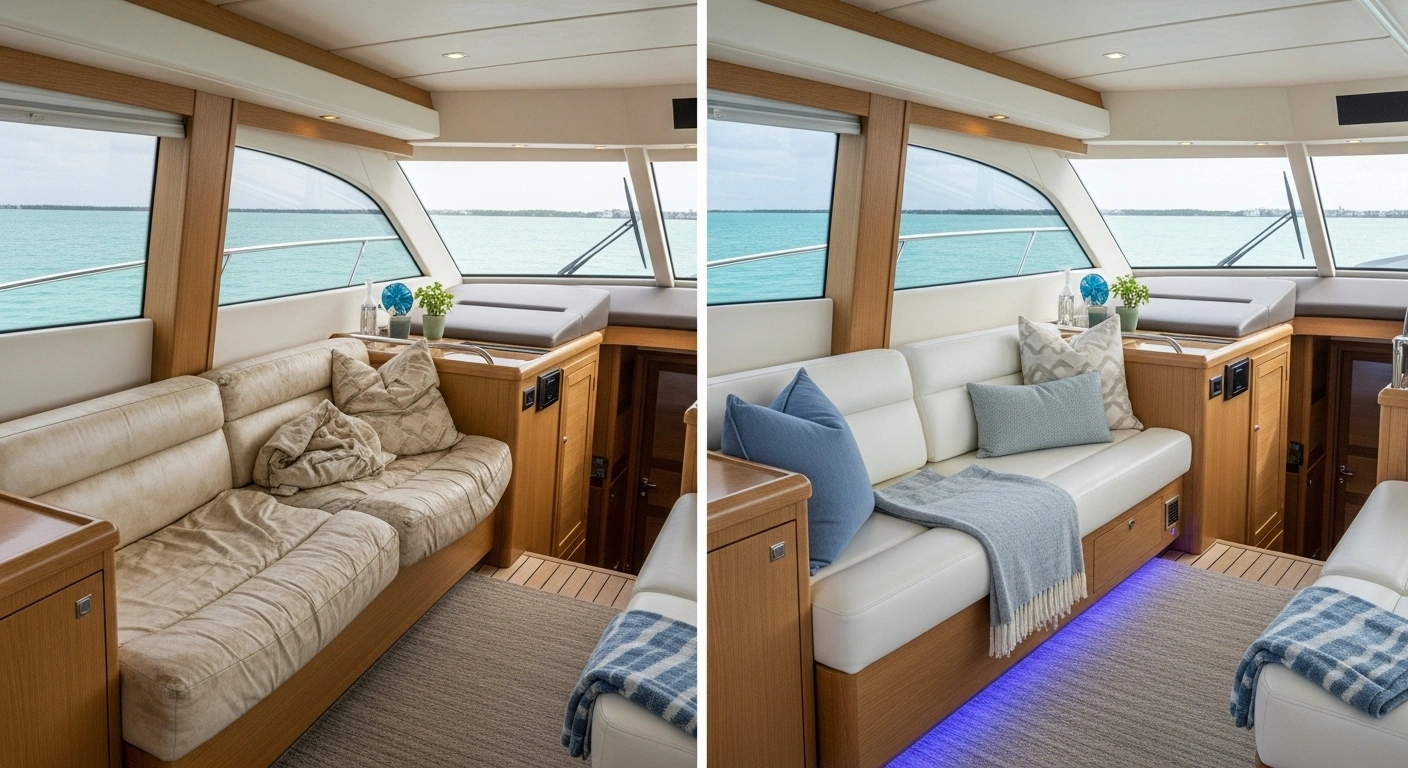Last year, I watched a boat owner spend $80,000 on what should have been a dream interior transformation.
His 45-foot Sea Ray looked like it belonged in a yacht magazine—Italian leather everywhere, custom millwork, imported fabrics that cost more per yard than most people spend on an entire cushion. The whole thing was beautiful.
Six months later, he was calling me to fix everything that had gone wrong.
The problem? None of it was designed for South Florida.
Within six months, the leather had cracked despite being kept in a covered slip at Las Olas. The custom woodwork warped from humidity swings. Those gorgeous imported fabrics developed mildew stains that professional cleaning couldn’t touch.
They had created architectural luxury for a marine environment… and it was a costly lesson that we see too often in our South Florida marine upholstery business.
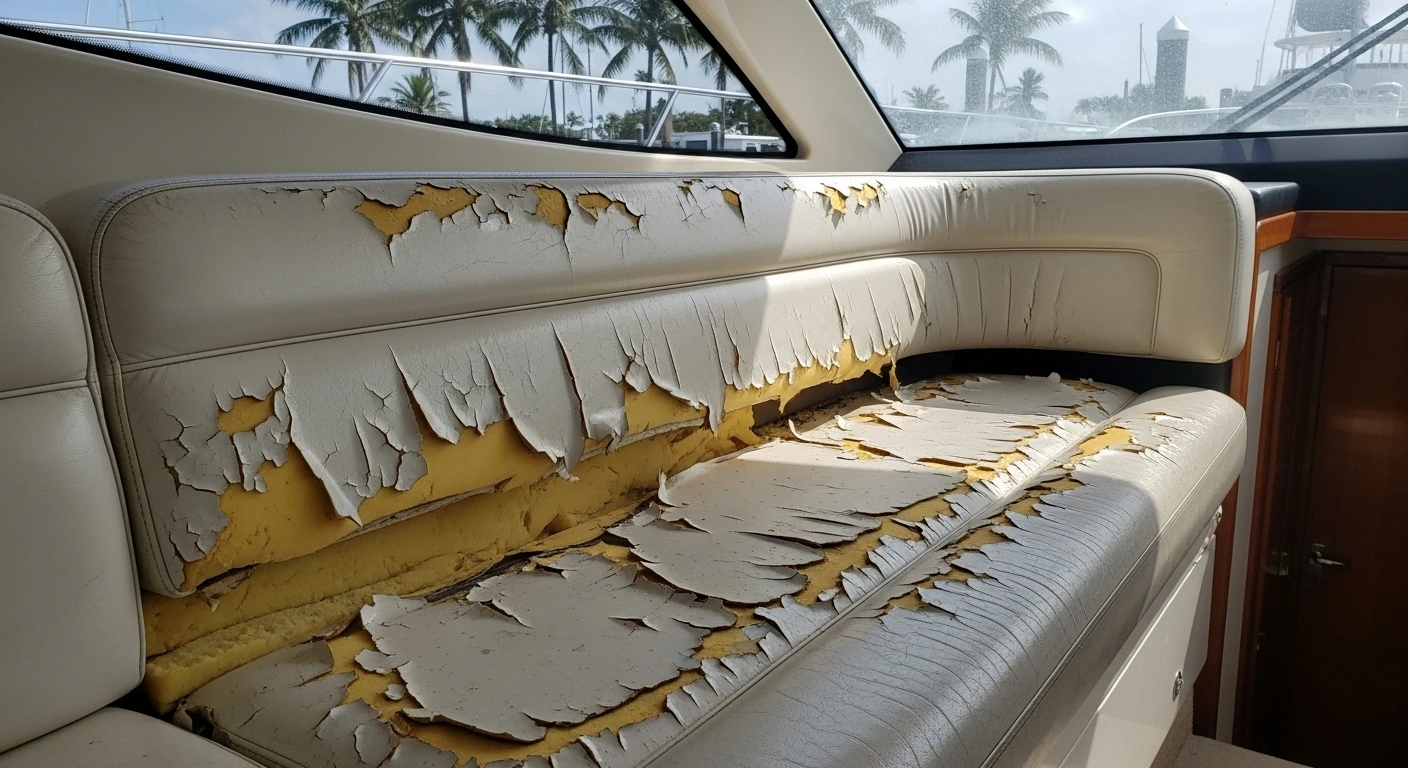
That’s actually how I got into this specialized field—fixing these expensive mistakes and figuring out what actually works. After 15 years of transforming boat interiors from Miami to Jupiter (and rescuing plenty of failed projects like that Sea Ray), I’ve learned that luxury and durability aren’t enemies. They just need to be introduced properly.
Here’s what I wish that boat owner had known before he spent $80,000 learning it the hard way.
The Florida Factor (Why Everything Changes Down Here)
Working with boat owners throughout Miami-Dade, Broward, and Palm Beach counties, I’ve seen every type of interior failure our climate can dish out.
South Florida isn’t just “marine conditions”. It’s marine conditions on steroids:
- Surface temperatures that hit 95°F with 90% humidity
- UV levels so intense they make Arizona look shady
- Salt air that doesn’t take a day off
- Year-round exposure (no winter storage reprieve)
Hence every project we take on has to pass our climate test:
Will it thrive in these conditions for years, not just survive them for months?
Because surviving usually means looking terrible while doing it—and that’s not what our clients pay for.
Think Like a Pro (Why Assessment Matters)
That Sea Ray disaster? It could have been prevented with proper assessment. It’s not the budget—it’s starting with the right questions.
So before you fall in love with any fabric or design, walk onto your boat and really look around. Not at what you want to change, but at what’s actually happening.
Ventilation Reality Check: Stand in your cabin on a humid day. Can you actually breathe comfortably? If the answer is no, your expensive new upholstery won’t be able to either. Poor ventilation is the serial killer of boat interiors in Florida.
The Water Detective Game: Look for water stains, even tiny ones. They’re telling you stories about where moisture goes when it gets inside (and it will get inside). Ignore these stories at your own peril.
Electrical Capacity: Modern amenities need proper power. Count everything that plugs in or lights up on your boat right now. Now add everything you want to add. Does your electrical system laugh at this number or cry? Be honest.
Foundation Test: Custom furniture and storage need solid mounting points. Push on furniture mounting points. Wiggle things that shouldn’t wiggle. If your boat’s structure isn’t solid, nothing you put on top of it will be either.
This assessment phase has saved our clients thousands in potential failures. It’s why we insist on it for every project… and why we’ve never had a Sea Ray situation in our 15 years of business.
And yes, it isn’t sexy work, but it’s the difference between looking like a pro and looking like someone who learned expensive lessons the hard way.
The Smart Phased Approach: How To Transform Your Vessel
Here’s something most boat owners don’t realize: trying to do everything at once is usually what leads to those $80,000 disasters. The pros approach major transformations in phases, and there’s a good reason why.
Quick Reference: Professional Boat Interior Transformation Timeline
Here’s how transformations actually happen when you do them right:
| Phase | Duration | Budget Split | What We Focus On |
|---|---|---|---|
| Design & Planning | 2-4 weeks | 5-10% | Assessment, marine-grade material selection |
| Infrastructure Work | 2-6 weeks | 30-40% | Ventilation, electrical, structural prep |
| Custom Upholstery & Storage | 4-8 weeks | 60% | Our specialty: custom fabrication and installation |
| Technology & Finishing | 1-3 weeks | 10% | Lighting, hardware, final details |
Phase 1: Planning and Foundation (35-50% of budget)
This is where most people want to rush, but it’s the phase that determines whether everything else succeeds or fails.
Assessment and material selection: Facing uncomfortable truths about your electrical system and choosing materials that will actually survive South Florida.
Infrastructure work: Electrical upgrades, ventilation improvements, structural fixes—the unglamorous stuff that makes everything else possible.
Notice that foundation work gets a big chunk of the budget. That’s not a mistake—it’s what separates transformations that last from expensive do-overs.
Phase 2: The Fun Part (60% of budget)
Once your foundation is solid, now you can focus on the exciting visual and functional improvements.
Custom upholstery and storage solutions: Where the magic happens and your boat starts looking like your vision.
Layout optimization: Making your space work better, not just look better.
Phase 3: Technology and Finishing (10% of budget)
The final touches that complete the transformation.
Lighting and entertainment systems: The details that make everything feel professionally designed.
Premium hardware and luxury touches: What elevates a nice renovation into something special.
The beauty of this approach? You can live with each phase and learn what works before committing to the next level. Plus, spreading the investment over time makes the whole project more manageable.
What Materials Actually Work Here
We’ve tested pretty much every marine fabric that exists in South Florida conditions. Our material library isn’t just pretty samples—it’s battle-tested proof of what survives and what doesn’t. When we recommend something, it’s because we’ve seen it perform for years, not just because it looks good in the showroom.
Fabrics We Trust
Solution-dyed marine acrylics (like Sunbrella Marine) are your best friend. The color isn’t painted on top—it goes all the way through the fiber. You can literally bleach these fabrics and they won’t fade. I’ve watched clients try to destroy Sunbrella samples just to test this. The fabric always wins.
Premium marine vinyl with real UV protection built into the material itself. Not sprayed on, not dipped in—actually part of the vinyl. It costs about 40% more than the regular stuff, but it lasts three times longer. Do the math.
Properly treated marine leather that’s been specifically processed for continuous UV and salt exposure. Regular leather, even expensive regular leather, will crack faster than a bad joke in our climate.
Our Color Strategy for South Florida
Nobody warned me about this when I started: color choice in South Florida is basically heat management disguised as decorating.
Light colors stay cooler. Dark colors become torture devices. I’ve measured 30-degree differences between white and black surfaces on the same boat.
But all-white gets boring and shows every speck of dirt (and there will be dirt).
My advice? Go with light colors and add darker accents in shady spots. Navy, deep green, burgundy - those colors don’t fade like crazy in the sun.
Stay away from bright reds, oranges, purples. I’ve watched too many of those turn pink after a few months.
Custom Upholstery: Where the Magic Happens
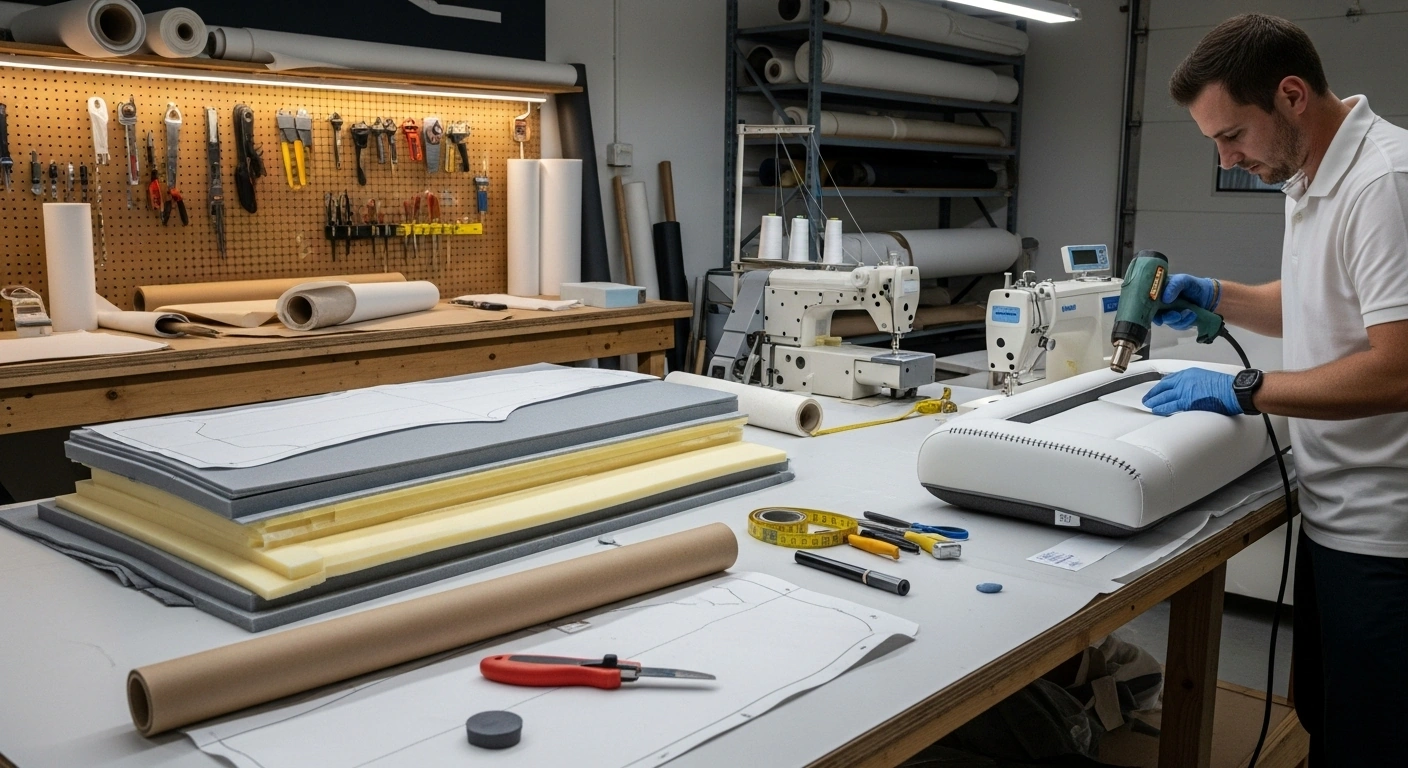
Now that you know which materials work, let’s talk about how to use them properly. This is where most boat transformations either come together beautifully or fall apart completely.
Here’s what sets our approach apart: we don’t just make cushions—we solve the problems that make boat interiors frustrating to live with. That means redesigning layouts that don’t work, fixing ventilation issues that kill materials, and creating storage that actually makes sense for how you use your boat.
So here’s the real pro move: don’t just recover what’s there. Ask what should be there.
Layout Optimization
Traffic flow: Can you actually move around your boat safely when it’s rocking? Or do you currently play furniture gymnastics every time there’s a wake?
Multi-function everything: Why have a seat that’s just a seat when it could be a seat with storage? Why have storage that requires removing three cushions to access?
Accessibility enhancements: Strategic handholds, non-slip surfaces, and easy entry/exit points that make your boat safer and more comfortable.
Custom Storage Solutions
Speaking of storage, I can tell you the exact moment someone realizes their boat has terrible storage: it’s when they’re trying to find something important while the boat is moving and everything they own is sliding around like it’s in a washing machine.
Good marine storage isn’t about fitting more stuff in less space—it’s about making sure everything stays where you put it and you can find it when you need it.
Our Three-Tier Storage Philosophy
- Daily essentials: Within arm’s reach of where you actually use them
- Occasional items: Accessible but not consuming prime space
- Emergency equipment: Designated, clearly marked, never blocked
Motion-Secure Design
Here’s a simple test: imagine your boat tilting 30 degrees in any direction right now. What falls out of where it’s supposed to be? That’s what needs better storage.
Every piece of storage needs to pass the “will this work when the boat is bouncing around like a mechanical bull” test.
Lighting and Climate Control: The Details That Make the Difference
Once you’ve got your upholstery and storage sorted, it’s time to focus on the elements that transform a functional space into something truly special. This is where good boats become great boats.
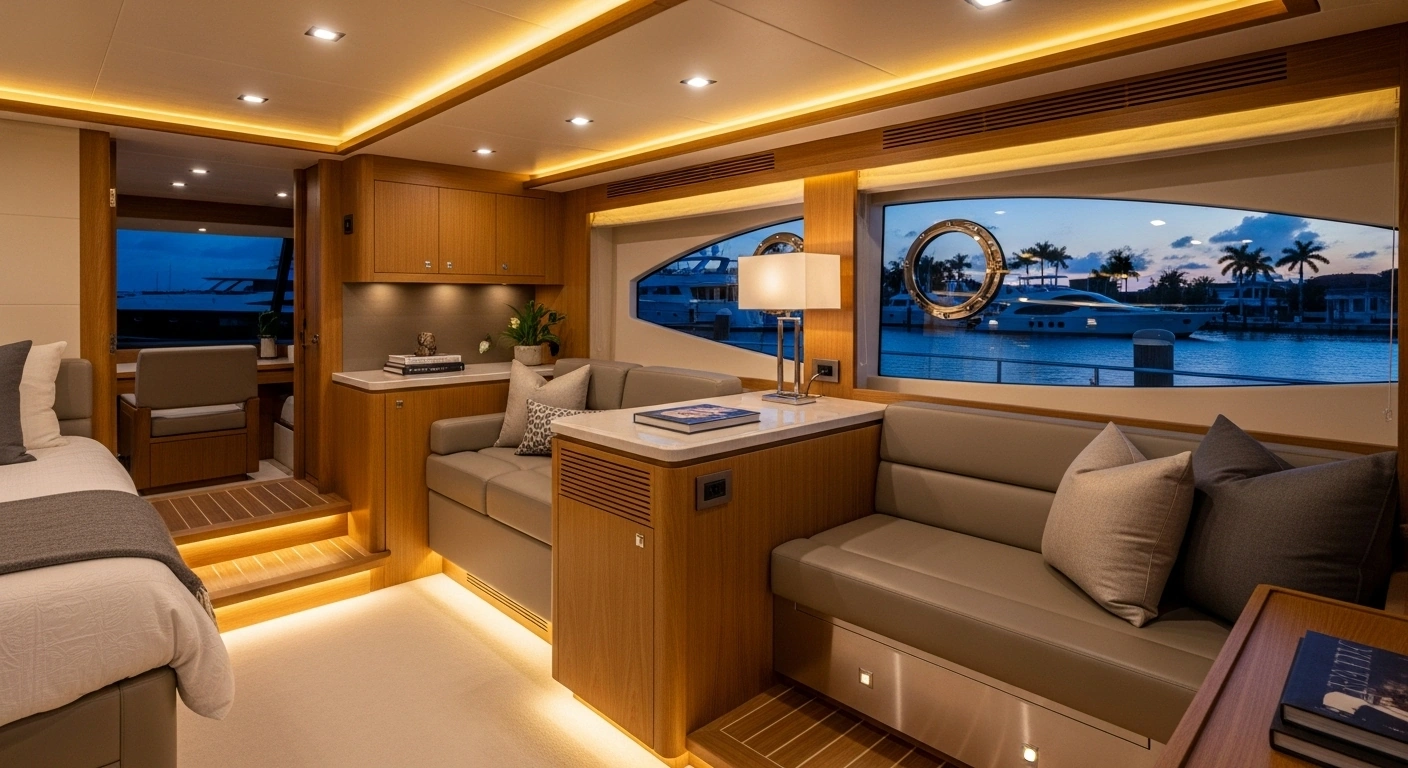
Professional Lighting Design
Lighting is where you can take a decent interior and make it absolutely magical. Or take an expensive interior and make it feel like a dentist’s office.
The difference is understanding that boats need three different types of light:
- Ambient lighting: General illumination without harsh shadows
- Task lighting: Focused light for specific activities (like reading, cooking, etc)
- Accent lighting: Decorative elements that create depth and luxury feel
Most boats have only harsh overhead lighting. We add the other layers to create spaces that feel professionally designed.
The LED Revolution
LEDs have changed everything in marine lighting. They use 90% less power, produce almost no heat, and last basically forever.
But the real game-changer is color options. Because different color temperatures create different moods and serve different functions:
- Warm white (2700K-3000K): Cozy, intimate atmospheres for evening entertaining
- Neutral white (3500K-4000K): Balanced light for most daily activities
- Cool white (5000K-6500K): Bright, energizing light for detailed work
- Red lighting: Preserves night vision for navigation and safety
💡 Pro Tip: Layer Everything
Start with good ambient lighting, add task lighting where you actually do things, then use accent lighting to create the mood you want. The result? An interior that feels professionally designed instead of just adequately lit.
Climate Control: The Non-Negotiable Basics
And speaking of making spaces comfortable, Florida’s climate doesn’t negotiate. You either manage it proactively or it manages your boat interior for you (spoiler alert: you won’t like its management style).
Ventilation: Life or Death for Interiors
Without proper air movement, even the most expensive materials become science experiments. And not the good kind.
You need air coming in and air going out, and you need it to actually move through the space instead of just sitting there getting humid.
Natural airflow optimization: Hatches and vents positioned so air actually flows through instead of just sitting in corners being stagnant.
Powered ventilation: Fans that move real air, not just shuffle humidity around.
Smart controls: Systems that turn on when humidity gets dangerous, not when you remember to flip a switch.
UV Protection Strategies
The sun down here is aggressive. You need protection strategies that work without turning your boat into a cave. Like:
Interior treatments: Window films and shades that block harmful UV while preserving visibility.
Exterior solutions: Shade systems that expand usable space while protecting interior areas.
Professional vs DIY: When to Call Us
Some things are perfect DIY projects. Others will cost you more in mistakes than professional help would have cost upfront.
Appropriate DIY Projects
- Simple hardware swaps (handles, basic latches)
- Direct LED replacements for existing fixtures
- Basic organization systems
When Our Expertise Matters
- Custom upholstery fabrication: Complex marine shapes, integrated features, proper material selection
- Electrical system modifications: Safe, code-compliant power upgrades
- Structural work: Proper mounting, reinforcement, water management
- Integrated storage systems: Custom solutions that actually work in marine conditions
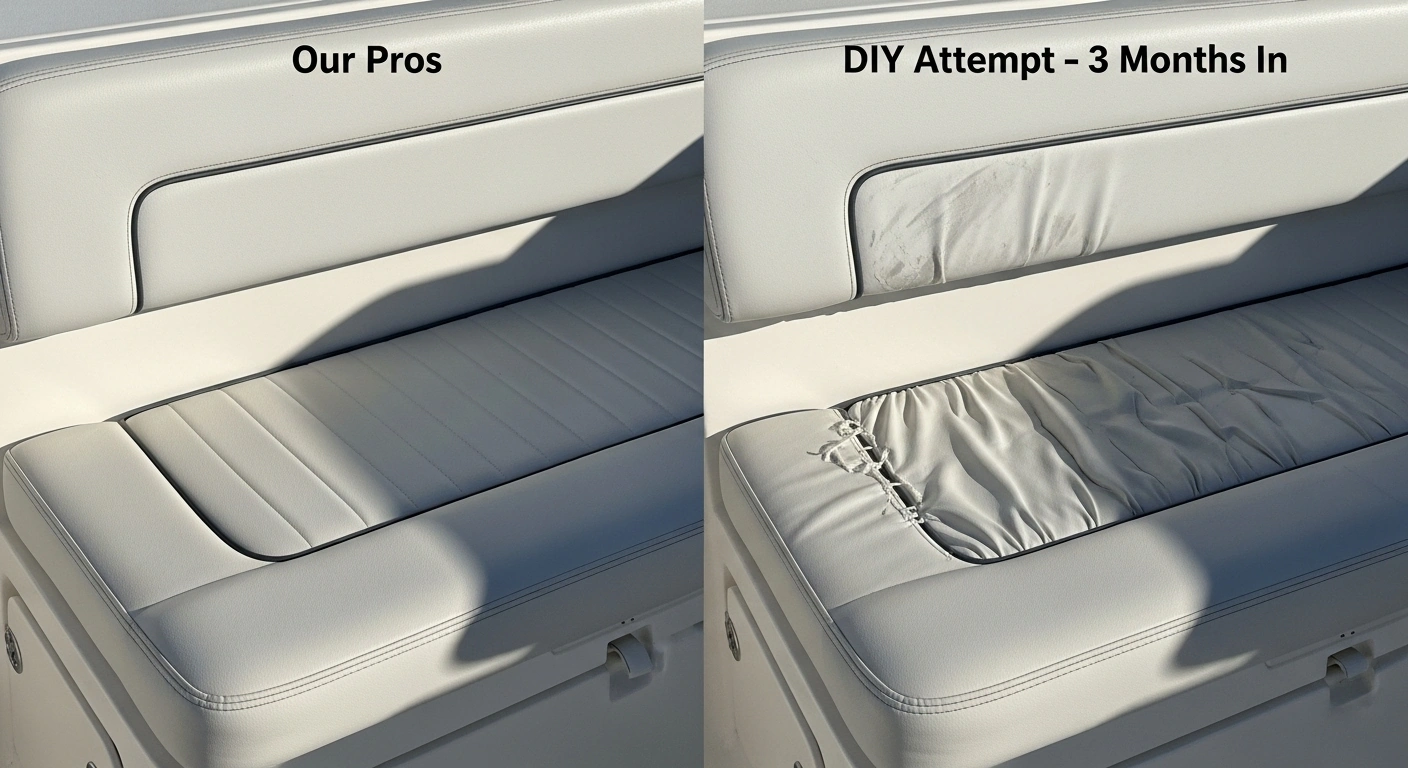
I’ve seen too many “simple” projects turn into expensive rescue missions to recommend tackling complex work without proper experience.
Maintaining Your Investment
The most beautiful transformation in the world becomes worthless without proper maintenance. And maintenance in South Florida is its own special challenge.
Our Maintenance Recommendations
- After every use: Fresh water rinse, proper drying procedures. This single step prevents 90% of long-term problems. Salt residue is your enemy—remove it before it can crystallize and embed in materials.
- Weekly: Real cleaning with products designed for marine environments, not household cleaners.
- Monthly: UV protection treatments using professional-grade products.
- Seasonally: Professional inspection and deep cleaning service.
It sounds like a lot, but it’s way less work than replacing everything every few years.
Why Choose Professional Marine Upholstery
Remember that Sea Ray disaster? That’s exactly why material choice matters so much here. Pretty doesn’t mean it works. Expensive doesn’t mean it lasts.
Fifteen years of this work teaches you what survives and what doesn’t. We’ve fixed enough disasters to know the difference.
The good news? You don’t have to pick between pretty and durable. You can have both.
Ready to Transform Your Boat the Right Way?
South Florida boat interiors are a different beast, and they require someone who actually understands what works down here.
Here’s what I suggest: Start with an honest assessment. Even if you’re planning to DIY part of the project, knowing what you’re really working with will save you thousands in mistakes.
We offer complimentary consultations for boat owners throughout Miami-Dade, Broward, and Palm Beach counties. We’ll walk through your boat together, talk about what you want to achieve, and we’ll give you straight talk about what will work and what won’t.
Schedule Your Complimentary Assessment or call us directly at (305) 331-1730.
You’ll sleep better knowing you’re doing this right the first time.
